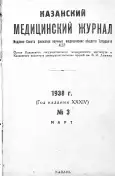Патогенез аппендицита и феномен Шварцмана
- Авторы: Нежданов В.М.1,2
-
Учреждения:
- Казанский государственный медицинский институт
- Казанский туберкулезный институт
- Выпуск: Том 34, № 3 (1938)
- Страницы: 303-308
- Тип: Статьи
- URL: https://journals.rcsi.science/kazanmedj/article/view/55145
- DOI: https://doi.org/10.17816/kazmj55145
- ID: 55145
Цитировать
Полный текст
Аннотация
Воспаление червеобразного отростка является наиболее частой формой воспалительных процессов в брюшной полости. По статистическим данным 30—35% всех хирургических больных оперируются по поводу аппендицита. Исследованиями различных авторов доказано, что аппендицит развивается в результате воздействия вирулентных бактерий на слизистую оболочку червеобразного отростка. До сих пор не удалось установить, существует ли специфический возбудитель аппендицита, хотя многочисленные исследования в этой области позволили бы это сделать, если бы таковой в действительности существовал (Ру- башев). Розенов в своих исследованиях в 70% случаев аппендицита обнаружил особый вид стрептококков, которые, по его мнению, вызывают аппендицит. Уиль выделил анаэроб, похожий на Вас. perfringens и bac. oedematis (при острых аппендицитах): По мнению Ашофа (1927) аппендицит вызывают Diplostreptococ- cus (enterococcus) и грамположительные палочки. Фонио (1923) полагает, что аппендицит вызывается особым грампозитивным диплококком и особой тонкой палочкой; такого же мнения придерживается и Фишер. Однако, все эти данные не получили общего подтверждения и наличие специфического возбудителя не доказано. По исследованию многих авторов (Деджен и Ми- чинер, Джингс, Брютт и др.) мы при аппендиците имеем смешанную инфекцию с преобладанием в острых случаях стрептококков и кишечной палочки. Бактериологии аппендицита посвящено много работ, перечислить которые невозможно в нашей краткой работе, вывод можно сделать следующий: заболевания отростка вызываются смешанной инфекцией. Нормальный отросток всегда содержит различные микробные формы. При хронических аппендицитах также всегда содержатся различные виды микробов. Каковы же пути возникновения аппендицита? Путь энтерогенный—заболевание отростка вызывается микробами, находящимися в самом отростке, в связи с ненормальными условиями для его питания и положения. Сюда относятся всякого рода закрытия просвета содержимым, будет ли это полужидкое содержимое отростка, каловый камень, припухание слизистой или что-нибудь иное. Такие же механические препятствия могут создавать перегибы отростка и забрюшинное его положение. Все эти моменты сводятся к теории так наз. „cavité close“ (Таламон) (1892), Дьелафуа (1896). Несмотря на различные возражения и противоречащие факты, мысль, высказанная Дьелафуа, сохраняет свою силу и до настоящего времени. Это положение подтверждается многочисленными исследованиями Босено (1897), Рувиль, Буа-Гейд (1912), Гейль, Мордвинкина и других не как единственная причина возникновения аппендицита, но как момент, способствующий ему.
Ключевые слова
Полный текст
Открыть статью на сайте журналаОб авторах
В. М. Нежданов
Казанский государственный медицинский институт; Казанский туберкулезный институт
Автор, ответственный за переписку.
Email: info@eco-vector.com
Факультетская хирургическая клиника имени заслуженного деятеля науки проф. Вишневского; Экспериментального отделения
РоссияСписок литературы
Дополнительные файлы






